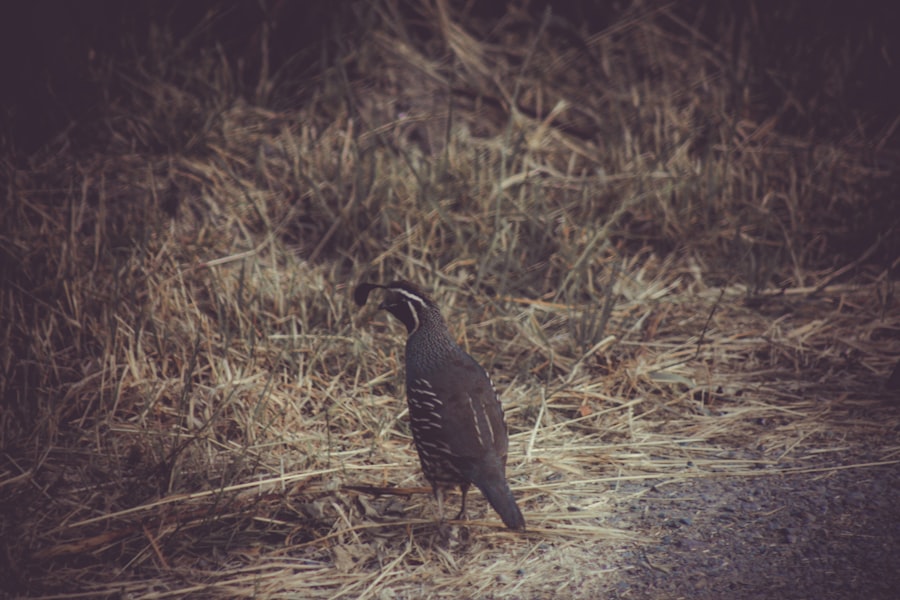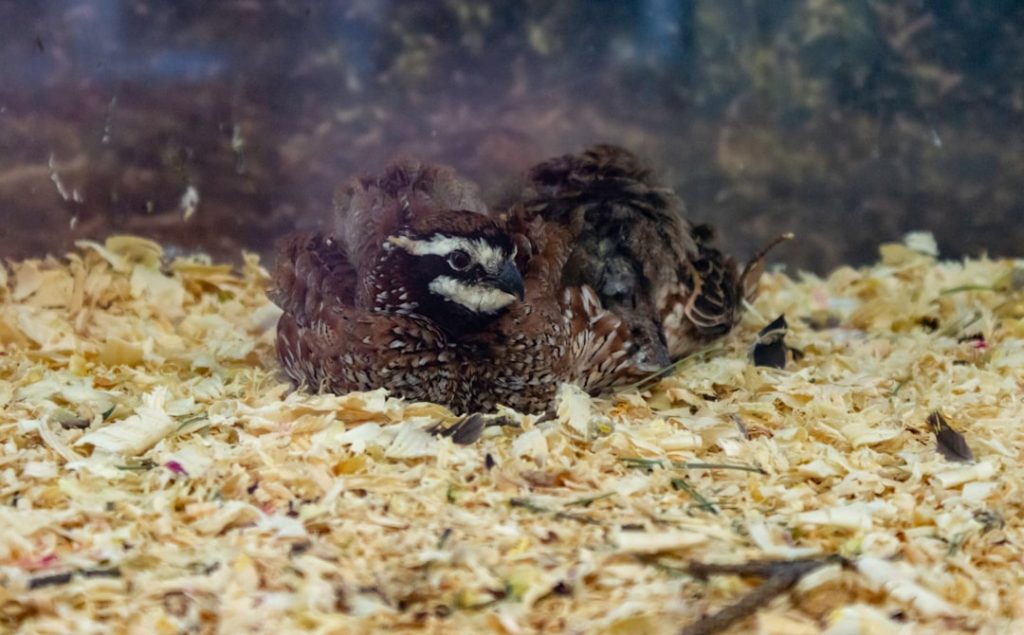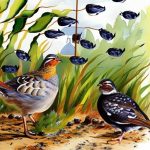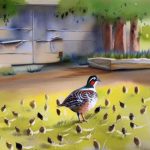Selecting the right breeding pair is crucial for a successful quail breeding program. When choosing a breeding pair, it’s important to consider the health, genetics, and temperament of the birds. Look for birds that are in good physical condition, with bright eyes, clean feathers, and a healthy weight. It’s also important to consider the genetic diversity of the birds to avoid inbreeding and maintain a strong and healthy gene pool. Additionally, observe the behavior of the birds to ensure they are compatible and will not exhibit aggressive or territorial behavior towards each other.
Furthermore, it’s essential to consider the age of the breeding pair. Quails reach sexual maturity at around 6-8 weeks of age, but it’s best to wait until they are at least 10-12 weeks old before breeding to ensure they are fully developed and mature enough to handle the demands of breeding. When selecting a breeding pair, it’s also important to consider their lineage and any potential genetic issues that may be present. By carefully selecting a breeding pair with strong genetics, good health, and compatible behavior, you can set the stage for a successful and productive breeding program.
Table of Contents
Key Takeaways
- Choose breeding pairs with good genetic diversity and no history of health issues
- Understand quail behavior to ensure successful breeding and minimize stress
- Create a breeding environment with proper lighting, temperature, and nesting materials
- Monitor breeding pairs for signs of aggression, illness, or infertility
- Provide breeding pairs with a balanced diet, clean water, and regular health checks
- Manage breeding challenges such as egg binding or infertility with proper care and intervention
- Maximize breeding success by providing a stress-free environment and proper care for breeding pairs
Understanding Quail Behavior
Understanding quail behavior is essential for successful breeding. Quails are social birds that thrive in groups, so it’s important to provide them with plenty of space and opportunities for social interaction. Additionally, quails are known for their territorial behavior, especially during the breeding season. It’s important to provide breeding pairs with separate nesting areas to reduce competition and aggression. Understanding the natural mating behaviors of quails is also important for successful breeding. Male quails will often perform a courtship display to attract females, so providing a suitable environment for this behavior is essential for successful mating.
Furthermore, understanding the nesting and brooding behaviors of quails is crucial for successful breeding. Female quails will seek out secluded areas to build their nests and lay their eggs, so providing suitable nesting materials and privacy is essential. Additionally, understanding the incubation and brooding behaviors of quails is important for successfully hatching and raising chicks. By understanding the natural behaviors of quails and providing a suitable environment that supports their social, mating, nesting, and brooding behaviors, you can create an ideal environment for successful breeding.
Creating the Ideal Breeding Environment
Creating the ideal breeding environment is essential for successful quail breeding. The breeding environment should provide ample space for the birds to move around and engage in natural behaviors. A spacious and well-ventilated coop or aviary is essential for providing a healthy and comfortable environment for breeding pairs. Additionally, providing suitable nesting areas with plenty of privacy is crucial for encouraging successful breeding behavior. Nesting boxes or areas should be secluded and lined with suitable nesting materials such as straw or shredded paper to provide a comfortable and secure environment for laying eggs.
Furthermore, providing a suitable diet is essential for creating an ideal breeding environment. Breeding pairs should be provided with a high-quality feed that is specifically formulated for quails and contains the necessary nutrients for optimal health and reproductive success. Additionally, providing access to fresh water at all times is crucial for maintaining the health and well-being of breeding pairs. Creating a suitable lighting schedule is also important for encouraging natural mating behaviors and reproductive success. By creating an ideal breeding environment that provides ample space, privacy, suitable nesting areas, a high-quality diet, and appropriate lighting, you can set the stage for successful quail breeding.
Monitoring the Breeding Process
Monitoring the breeding process is essential for ensuring the health and well-being of breeding pairs and maximizing breeding success. Regularly observing the behavior and condition of breeding pairs can help identify any potential issues or challenges that may arise during the breeding process. It’s important to monitor the behavior of the birds for signs of aggression, stress, or illness, as these can impact reproductive success. Additionally, monitoring the nesting areas for signs of egg production and brooding behavior can help ensure that breeding pairs have suitable conditions for successful reproduction.
Furthermore, monitoring the eggs for signs of fertility and development is crucial for maximizing breeding success. Candling eggs can help determine if they are fertile and developing properly, allowing you to remove any infertile or damaged eggs to prevent them from impacting the rest of the clutch. Monitoring the incubation process is also important for ensuring that eggs are kept at the appropriate temperature and humidity levels for successful hatching. By regularly monitoring the behavior of breeding pairs, the condition of nesting areas, and the development of eggs, you can identify any potential issues early on and take steps to address them to maximize breeding success.
Caring for Breeding Pairs
Caring for breeding pairs is essential for ensuring their health and well-being throughout the breeding process. Providing a high-quality diet that is rich in protein and essential nutrients is crucial for supporting the reproductive health of breeding pairs. Additionally, providing access to fresh water at all times is essential for maintaining hydration and overall health. It’s also important to provide regular opportunities for exercise and social interaction to prevent boredom and reduce stress.
Furthermore, providing suitable nesting materials and privacy is essential for creating a comfortable and secure environment for laying eggs and raising chicks. Regularly cleaning nesting areas and removing soiled bedding can help prevent the spread of disease and maintain a healthy environment for breeding pairs. Additionally, providing regular veterinary care and monitoring the health of breeding pairs is important for identifying any potential health issues early on and taking steps to address them. By providing attentive care that supports the reproductive health and overall well-being of breeding pairs, you can help maximize their breeding success.
Managing Breeding Challenges

Managing breeding challenges is an important aspect of successful quail breeding. One common challenge that breeders may face is aggression between breeding pairs. Providing separate nesting areas and ample space can help reduce competition and aggression between pairs. Additionally, closely monitoring the behavior of breeding pairs can help identify any potential issues early on and take steps to address them before they escalate.
Furthermore, managing fertility issues is another common challenge in quail breeding. If breeding pairs are not producing fertile eggs, it’s important to evaluate their diet, environment, and overall health to identify potential factors that may be impacting fertility. Adjusting their diet, providing additional privacy or nesting materials, or seeking veterinary care may help address fertility issues and improve reproductive success. By actively managing breeding challenges and taking steps to address them early on, you can help ensure the overall success of your quail breeding program.
Maximizing Breeding Success
Maximizing breeding success requires careful attention to all aspects of the breeding process. Providing a suitable environment that supports natural mating behaviors, nesting, incubation, and brooding is essential for maximizing reproductive success. Additionally, selecting strong breeding pairs with good genetics, health, and compatible behavior can set the stage for successful reproduction.
Furthermore, closely monitoring the behavior and condition of breeding pairs, as well as the development of eggs, can help identify any potential issues early on and take steps to address them to maximize reproductive success. Providing attentive care that supports the reproductive health and overall well-being of breeding pairs is crucial for maximizing their breeding success. By actively managing breeding challenges and taking steps to address them early on, you can help ensure the overall success of your quail breeding program.
In conclusion, successful quail breeding requires careful consideration of all aspects of the process, from selecting strong breeding pairs to creating an ideal environment, monitoring the breeding process, caring for breeding pairs, managing challenges, and maximizing reproductive success. By understanding quail behavior and providing a suitable environment that supports their natural behaviors, you can create an ideal environment for successful reproduction. With attentive care and proactive management of potential challenges, you can help ensure the overall success of your quail breeding program.
If you’re considering quail breeding pairs, it’s essential to provide them with a suitable environment. A well-designed chicken coop can serve as a great model for a quail enclosure. In fact, Poultry Wizard has an informative article on the importance of the size of a coop for chickens, which can also be applied to quails. Understanding the space requirements for poultry is crucial for their well-being and productivity. Check out their article on how big a coop needs to be for a chicken to gain valuable insights that can be adapted for your quail breeding setup.
FAQs
What is a quail breeding pair?
A quail breeding pair consists of a male and a female quail that are kept together for the purpose of producing offspring. These pairs are commonly used in quail farming and breeding operations.
How do you select a quail breeding pair?
When selecting a quail breeding pair, it is important to choose healthy, mature birds with no genetic defects. Look for birds that are active, have good body conformation, and show no signs of illness or injury.
How do you care for quail breeding pairs?
Quail breeding pairs should be provided with a clean and spacious enclosure that includes nesting boxes, feeders, and waterers. They should be fed a balanced diet of quail feed and have access to clean water at all times. Regular monitoring of their health and behavior is also important.
How often do quail breeding pairs lay eggs?
Quail breeding pairs typically lay eggs every 1-2 days, depending on the breed and environmental conditions. It is important to collect the eggs regularly to prevent them from being damaged or eaten by the quail.
What is the incubation period for quail eggs?
The incubation period for quail eggs is approximately 17-18 days. During this time, the eggs should be kept in a clean and properly maintained incubator with the appropriate temperature and humidity levels.
How do you introduce a new quail breeding pair?
When introducing a new quail breeding pair, it is important to do so gradually to minimize stress and aggression. Place the new pair in a separate enclosure within sight of the existing pair for a few days before allowing them to interact directly. Keep a close eye on their behavior to ensure they are getting along.
Meet Walter, the feathered-friend fanatic of Florida! Nestled in the sunshine state, Walter struts through life with his feathered companions, clucking his way to happiness. With a coop that’s fancier than a five-star hotel, he’s the Don Juan of the chicken world. When he’s not teaching his hens to do the cha-cha, you’ll find him in a heated debate with his prized rooster, Sir Clucks-a-Lot. Walter’s poultry passion is no yolk; he’s the sunny-side-up guy you never knew you needed in your flock of friends!







